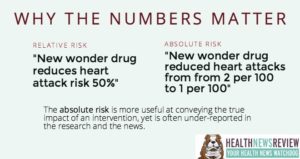In our series, Medical News: What Can You Believe?, Dr. Kathryn Hayward and Dr. Bill Manahan explore the whirlwind of news reports that tell us to do things for our health. Many reports point people in the direction of taking medications, which raises red flags like economic incentives and medication side effects. Some people wonder, “What can I do to avoid taking unnecessary medications?”
Part 1 of our series focused on the new guidelines for high blood pressure, which will abruptly award that diagnosis to millions of people, opening up markets for the five types of blood pressure-lowering medications.
Part 2 is about osteoporosis, and the efforts to convince women that they need particular drugs to maintain bone health.
Part 2: Disturbing Data
By Bill Manahan, MD
 What can you believe? Who can you believe? If you are not aware of the difference between Absolute (or Actual) Risk Reduction (ARR) and Relative Risk Reduction (RRR), you can easily be misled by the reporting of statistics by medical science. Let me give an example.
What can you believe? Who can you believe? If you are not aware of the difference between Absolute (or Actual) Risk Reduction (ARR) and Relative Risk Reduction (RRR), you can easily be misled by the reporting of statistics by medical science. Let me give an example.
Fosamax is a drug used to reduce the incidence of hip fractures. Merck Pharmaceutical advertised that taking this medication for four years (in a large group of older women) decreased the incidence of hip fracture by 50%. Wow! That is impressive – until you actually read the study.
In the women treated with Fosamax, 1 out of every 100 women suffered a hip fracture after 4 years. In the women NOT treated with Fosamax, 2 out of every 100 women suffered a hip fracture after 4 years. So, Fosamax was advertised as causing a 50% reduction in hip fractures (1 is half of 2). This play on words is called RRR, because it is not an actual reduction; rather it is a relative reduction. The actual reduction (ARR) was 1%.
I know very few older women who would take a drug that has significant side-effects if they actually were informed that it would only help ONE OUT OF 100 of them and would hurt at least 10 or 20 of those 100 with side effects from the Fosamax.
 I love science, but it really bothers me when my profession deliberately misleads the public for the sake of greater profit. And, unfortunately, this instance is not an isolated one. The RRR statistics are commonly used to tell us why we need to get the yearly flu vaccine, have various types of chemotherapy for solid tumor cancers, or take a statin drug for slightly elevated cholesterol.
I love science, but it really bothers me when my profession deliberately misleads the public for the sake of greater profit. And, unfortunately, this instance is not an isolated one. The RRR statistics are commonly used to tell us why we need to get the yearly flu vaccine, have various types of chemotherapy for solid tumor cancers, or take a statin drug for slightly elevated cholesterol.
I really appreciate the wonderful pharmaceuticals that are available to us, but we have given those companies way too much power to dictate to the medical industry and to our patients what drugs they should be taking. The U.S. is almost the only country in the world that allows direct drug advertising to the public, and that is not a good idea. Like advertising McDonald’s hamburgers, what you see looking so wonderful on your TV screen is not what is necessarily in your best interest.
At our International Integrators Living Whole immersion retreat June 17-22, 2018 in Avila, Spain, you will learn first-hand what foods truly are in your best interest. And, you will also learn lots of other exciting things like RRR and ARR!
 Bill Manahan, MD is Assistant Professor Emeritus with the Department of Family Medicine and Community Health at the University of Minnesota Medical School. He is Past-President of the American Holistic Medical Association and author of the book, Eat for Health. He founded The Wellness Center of Minnesota in 1982, one of the first physician-led integrative medicine centers in the country. In 1994, Bill co-founded Open Door Health Center in Mankato, MN, a clinic for the underserved and uninsured. The clinic is presently serving over 5,000 people each year with over 15,000 yearly visits.
Bill Manahan, MD is Assistant Professor Emeritus with the Department of Family Medicine and Community Health at the University of Minnesota Medical School. He is Past-President of the American Holistic Medical Association and author of the book, Eat for Health. He founded The Wellness Center of Minnesota in 1982, one of the first physician-led integrative medicine centers in the country. In 1994, Bill co-founded Open Door Health Center in Mankato, MN, a clinic for the underserved and uninsured. The clinic is presently serving over 5,000 people each year with over 15,000 yearly visits.
Bill also served, for many years, on the clinical faculty of Mayo Medical School in Rochester. During that time, Bill had over 80 Mayo medical students spend two to six weeks with him in his office. Bill helped pioneer two integrative medicine programs for medical students from North America. These programs are designed to educate and encourage medical students to become leaders in integrative medicine. The programs are known as the Leadership and Education Program for Students in Integrative Medicine (LEAPS into IM) and the Humanistic Elective in Activism and Reflective Transformation and Integrative Medicine (HEART-IM). Both of these programs are supported by the American Medical Student Association (AMSA).


